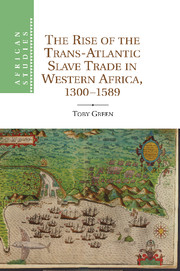Book contents
- Frontmatter
- Contents
- List of Maps
- Acknowledgements
- Abbreviations
- Glossary
- Introduction Rethinking the Trans-Atlantic Slave Trade from a Cultural Perspective
- Part One The Development Of An Atlantic Creole Culture In Western Africa, Circa 1300–1550
- 1 Culture, Trade and Diaspora in Pre-Atlantic Western Africa
- 2 The Formation of Early Atlantic Societies in Senegambia and Upper Guinea
- 3 The Settlement of Cabo Verde and Early Signs of Creolisation in Western Africa
- 4 The New Christian Diaspora in Cabo Verde and the Rise of a Creole Culture in Western Africa
- 5 The New Christian/Kassanké Alliance and the Consolidation of Creolisation
- Part Two Creolisation And Slavery
- Bibliography
- Index
3 - The Settlement of Cabo Verde and Early Signs of Creolisation in Western Africa
from Part One - The Development Of An Atlantic Creole Culture In Western Africa, Circa 1300–1550
Published online by Cambridge University Press: 05 November 2011
- Frontmatter
- Contents
- List of Maps
- Acknowledgements
- Abbreviations
- Glossary
- Introduction Rethinking the Trans-Atlantic Slave Trade from a Cultural Perspective
- Part One The Development Of An Atlantic Creole Culture In Western Africa, Circa 1300–1550
- 1 Culture, Trade and Diaspora in Pre-Atlantic Western Africa
- 2 The Formation of Early Atlantic Societies in Senegambia and Upper Guinea
- 3 The Settlement of Cabo Verde and Early Signs of Creolisation in Western Africa
- 4 The New Christian Diaspora in Cabo Verde and the Rise of a Creole Culture in Western Africa
- 5 The New Christian/Kassanké Alliance and the Consolidation of Creolisation
- Part Two Creolisation And Slavery
- Bibliography
- Index
Summary
In his account of the settlements on the Casamance and São Domingos Rivers discussed in the previous chapter, Valentim Fernandes stated that the main trading partners of these settlements were Caboverdeans. Here we get a glimpse of how, as we shall see in this chapter, the settlement of Cabo Verde from the 1460s onwards was a key factor in both the development of Creole communities in Western Africa and in the emergence of the trade networks of the early African Atlantic.
The ten large islands and numerous islets of Cabo Verde were initially settled by European sailors in the 1460s. In the sixteenth century there were two main inhabited islands, Santiago and Fogo. The archipelago offered a base for Europeans trading in Africa and swiftly became connected to the African coast, so that both islands and the coast were integrated into a single geopolitical zone. Economically, neither can be studied alone in this early period. Thus while recognising the priority of pre-existing African factors in shaping Atlantic exchanges in Upper Guinea, we must also accept the integration of Cabo Verde into the picture. This is particularly important for the understanding of the development of Creole communities; the Creole culture which emerged in Western Africa was one that spanned both the islands and the coast and did so because of the heavy interconnections between the two zones.
- Type
- Chapter
- Information
- Publisher: Cambridge University PressPrint publication year: 2011



